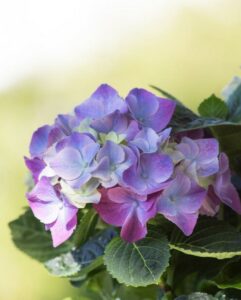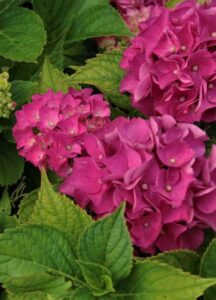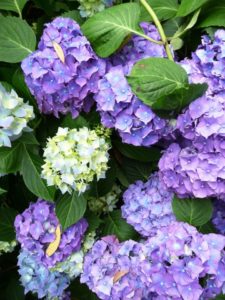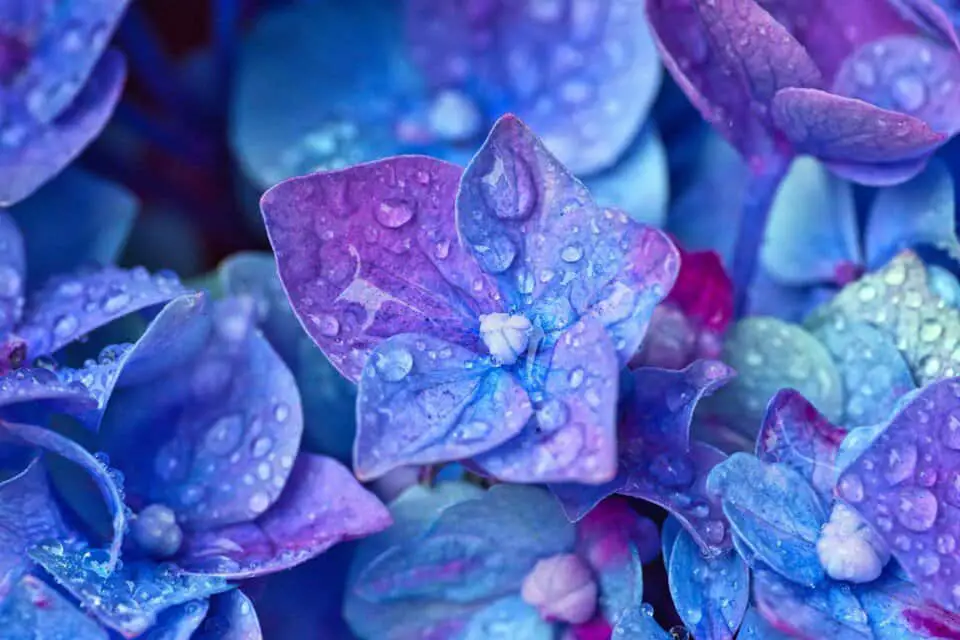Some links in the post are affiliate links and I get a commission from purchases made through some links found in the post.
Hydrangeas are lovely low-maintenance flowers that can make your living space aesthetically pleasing, but they need to be cared for properly to maintain their beautiful flowers and lush leaves.
When it comes to caring for this plant, the water requirements are an important factor that you need to know.
Hydrangeas need more water than other home plants and they do well in a constantly moist environment.
The water requirements for a hydrangea are that they should be watered deeply 2-3 times a week, however, this watering pattern may change with change in the climate conditions of your region.
It is important to know when to water this plant and how often to carry this task out. Fortunately, this article covers all these details including how to identify an underwatered or overwatered hydrangea plant.
How to Know When to Water a Hydrangea
 You have to keep your hydrangea soil moist but while doing that, you have to be careful not to overwater it.
You have to keep your hydrangea soil moist but while doing that, you have to be careful not to overwater it.
Keep an eye out for drooping leaves as it is a sign that your hydrangea needs more water, other signs of underwatering can also be a good indication but we will cover this in a different section.
Another good test to determine if your hydrangea needs water is to insert your finger about 2 inches into the soil of your hydrangea.
If your finger has some trace of water, then there is no need to water this plant, but if your finger comes out dry and without any soil sticking to it, then you will need to water the soil of this plant.
How to Water my Hydrangea from the Top?
Hydrangeas are prone to attack by diseases so it is advised that you do not wet its leaves as wet leaves create a perfect breeding environment for microorganisms.
To water hydrangeas correctly, you can install soaker hoses or a drip system as they deliver water directly to the soil of your plant without the water touching the leaves. An overhead sprinkler is a bad idea for watering your hydrangeas.
Automatic sprinklers may not be available to everyone, so watering can also suffice for his job.
If you are growing this plant on clay soil, then you will need some organic content to ensure that your soil holds just the right amount of moisture or if you are growing this plant on sandy soil that drains water quickly, organic content should also be mixed with it to increase its ability to retain moisture.
Water Requirements for Different Species of Hydrangeas
There are different species of hydrangeas and these species have different care conditions as well as water requirements. Some species will require more water to grow while others will require less.
Bigleaf Hydrangea (Hydrangea macrophylla)
This specie of hydrangea likes a consistent supply of moisture and if they don’t get the amount of moisture they need, their leaves will begin to droop.
This specie of hydrangea has big leaves that tend to lose moisture easily, watering it 1-3 times a day should sustain its growth.
Oakleaf Hydrangea (Hydrangea quercifolia)
A young oakleaf hydrangea loves an area with a decent supply of water. Oakleaf hydrangeas should be deeply watered 2-3 times a week, although mature ones are known drought resistant than any other type of hydrangea.
Panicle Hydrangea (Hydrangea paniculata)
Panicle hydrangea is not very selective when it comes to soil requirements unlike the others, it can even grow on clay soil, but you need to create a proper drainage channel.
This hydrangea will require a lot of water in its first and second year of growth, but beyond that, it can survive with less water
Smooth Hydrangea (Hydrangea arborescens)
According to North Carolina Extension Plant toolbox, smooth hydrangeas are commonly found in sloped areas and they grow in soil with medium moisture.
This specie of hydrangea is not water-loving like the others, however, new leaves of this hydrangea are not drought tolerant and will require as much moisture as possible.
Mountain Hydrangea (Hydrangea serrata)
Mountain hydrangea is also known as tough hydrangea. It is known to tolerate average moisture and sunlight as they have relatively small leaves that prevent excess loss of water via transpiration.
This specie also requires well-drained soil for optimal growth.
Climbing Hydrangea (Hydrangea anomala)
At the early stage of growth, climbing hydrangea should be watered between 2-3 times a week, you can also add some mulch to help retain some moisture. This hydrangea should be watered on its vines.
How Much Water do Hydrangeas Need when First Planted
 Moisture is equally important for newly planted hydrangeas as it helps them establish their root for healthy growth.
Moisture is equally important for newly planted hydrangeas as it helps them establish their root for healthy growth.
Newly planted hydrangeas will need more water than established hydrangeas, so they should be watered at least 3 times a week and they should be grown on rich soil and well-drained soil that can retain some amount of moisture for constant hydration of the plant.
The full growth of the roots of newly planted hydrangeas can be accomplished after 2-3 weeks, so within this period, this young plant should be kept moist at all times and should be cared for properly.
Even as these new hydrangeas need a considerable amount of moisture, you should be careful not to overwater them.
Young hydrangeas that are planted indoors will also require the same amount of water, but ensure that the excess water in the container is properly drained.
Mulch is also a good material that can help young hydrangeas retain moisture as they have shallow roots that are still growing, at this stage, one of the best options for mulch is hardwood but do not use dyed ones.
How Often Should you Water a Hydrangea in Winter?
Hydrangeas may be water-loving plants, but how often should you water them during winter.
During fall, this plant prepares for dormancy and then in winter, it becomes fully dormant which means it doesn’t produce new flowers or leaves.
If it’s a dry winter without snow or winter rain, then you can water your hydrangeas about once every month, but if there is snow or winter rain, then you can skip watering your hydrangeas during this season.
During winter, your hydrangeas won’t be producing so they won’t need a lot of water to survive.
How Often Should you Water a Hydrangea in Summer?
Summers are characterized by hot sunlight, but how often you water your hydrangeas in this period depends on the temperature.
In some regions, there is no significant difference between spring and summer so in a case like this, there is no need to change the frequency of watering this plant.
However, summer in other areas is often associated with a higher temperature and sun intensity.
If the temperature has risen, then you will need to increase the frequency of watering hydrangeas to about 3 to 4 times a week.
High temperature also contributes to a high rate of transpiration so your hydrangeas are likely to lose more moisture under these conditions.
What are the Signs your Hydrangea is Overwatered?
Knowing that hydrangeas need a lot of moisture, you may find yourself overwatering this plant.
Well, if your hydrangea does not have an excellent drainage system, you may be faced with root rot. Root rot is a condition where wet soil causes the roots of your hydrangea to rot.
Here are some unusual behaviors your hydrangeas may exhibit that may indicate the effects of overwatering your hydrangea.
Root Rot
This has been introduced earlier, and while it is not easy to see root rot, you can identify it by uprooting your hydrangeas and observing it.
If the roots of this plant are soft and brownish or sometimes black, then it indicates root rot. Normally, the roots of this plant should be white and firm.
You can cut off the affected root completely and treat your plant to prevent the rot from spreading, to prevent this from happening, create proper drainage channels to get rid of excess water.
Browning or Drooping of Leaves
When you supply excess water to this plant, the leaves also accumulate more water than is necessary.
The presence of this amount of water in the leaves can cause them to turn brown and have a squishy feeling, the discoloration is first observed at the edges and if this problem is not treated, the brown leaves will begin to wilt.
Yellowing of Leaves
 A hydrangea that is overwatered will develop chlorosis, a condition where the leaves of a plant turn yellow due to a lack of chlorophyll.
A hydrangea that is overwatered will develop chlorosis, a condition where the leaves of a plant turn yellow due to a lack of chlorophyll.
Yellow leaves lack nutrients necessary for the production of chlorophyll and good health of your hydrangeas.
One of the major causes of this is root damage by overwatering. Injured roots inhibit the transport of these nutrients to the leaves.
Leaves Falling Off
It may be somewhat normal for old leaves to drop, but when old and new leaves are dropping, it may be an indication of overwatering.
The cells in plant leaves are fed too much water which causes them to burst and die, the death of these cells weakens the petiole which in turn causes the leaves to fall off. Other leaves on this plant look weak.
Stunted Growth
A healthy hydrangea will grow new foliage or will continue to grow taller. However, if you notice a halt in this growth, it may be an indication of overwatering.
Stunted growth can also be a sign of other problems in your hydrangea so you may need to observe other symptoms before coming to the conclusion that your plant is being overwatered.
Visible Molds
The presence of excess water in the soil of this plant can encourage the activities of microorganisms which can lead to the formation of molds.
A soil condition like this will also facilitate the breeding of several fungal diseases which is bad for your plant.
What are the Signs your Hydrangea is Underwatered?
Water is important to the health of hydrangeas so when you cut back on this factor, your plant will show some signs to point out that it is underwatered.
Wilted Leaves
When your hydrangea is underwatered, it is dehydrated and will start to wilt.
Under watered plants will lose the last of the moisture in their via transpiration, this makes the cells in the leaves shrink and die which in turn causes the leaves to wilt.
A wilted hydrangea caused by underwatering will feel dry and crumbly, the exact opposite of an overwatered hydrangea.
Stunted Growth
Water is important for the growth of hydrangeas, so if your plant lacks moisture, you will notice a pause in the normal growth of this plant.
This stunted growth will be accompanied by other signs of underwatering.
Discoloration
The leaves of an underwatered hydrangea will turn brown before it starts to wilt.
This discoloration will first be observed from the edges of the leaves and then it will gradually spread throughout the leaves.
Curled Leaves
The absence of adequate moisture in hydrangeas causes the leaves to curl or fold. The leaves curl in an upward manner, this only intensifies if your plant is exposed to more sunlight.
Extra Watering Tips for your Hydrangea
 Some additional knowledge on watering this plant will help you avoid overwatering and underwatering your hydrangeas. Here are some helpful tips on how to water your hydrangeas properly.
Some additional knowledge on watering this plant will help you avoid overwatering and underwatering your hydrangeas. Here are some helpful tips on how to water your hydrangeas properly.
- Water your hydrangeas in the morning as the absence of midday sun leads to a low rate of evaporation, this way the moisture in your soil is preserved.
- Deeply water this plant 2-3 times a week
- Be sure that your soil is able to hold more moisture before watering, this prevents overwatering.
- The flowers and leaves of this plant are off limits when watering as hydrangeas are prone to diseases attacks with their leaves and flowers wet
- Water the soil of your hydrangea evenly and do not focus on a specific area alone to provide proper hydration.
- Deeply water hydrangeas immediately after transplant to aid transitioning, watering should also be done more often after transplant
- Have a consistent watering schedule
- Create proper drainage channels for indoor hydrangeas by making holes at the bottom of the container.
Final Thoughts
Watering hydrangeas may seem like a daunting task but it is not difficult if you understand the requirements and create a constant watering timetable.
Going through this article, you should have learned when and when not to water hydrangeas as well as how often this procedure can be done.


